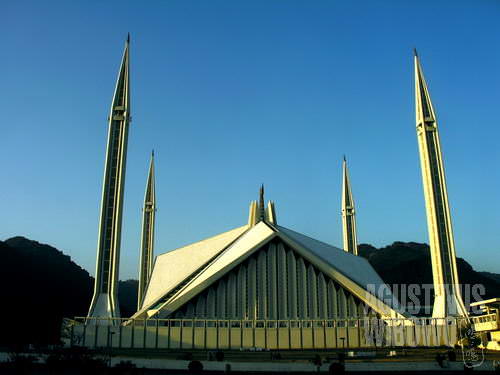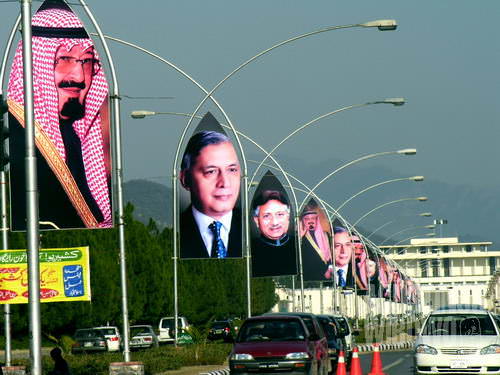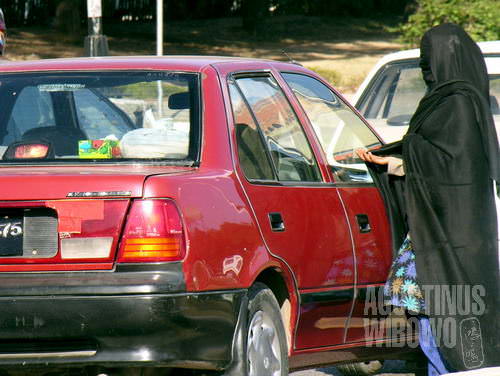Islamabad – The Capital of Pakistan

The modern Faisal Mosque, named after the king of Saudi Arabia
February 3, 2006
The capital of Pakistan, Islamabad- the name means the city of Islam, is a new city created just few decades ago. The designer of the city was a European, and it was designated to be a modern city. The roads are long, straight, with blocks of commercial regions, residential regions, and government offices. The names of the blocks and the roads are even in number, like F-7 for ths Jinnah Supermarket, or G-7 for the block opossite F-7 separated by the main road called ‘blue area’. The using of letter and number is not quite user-friendly. But it seems how it also goes in the West.
Nevertheless Islamabad is a new city, the roads are wide, but the population is not that much. The buildings looks more modern and clean than the nearby Rawalpindi, with obvious reason that the strata and level status of the inhabitants are higher, but the feeling of the city is totally empty. Not so much live, vibration, smell, and noise like in Rawalpindi, thus, it’s not the place where most visitors linger about.
The reason I go to Islamabad is usually only for documents or embassy visits. Today I wanted to visit the GPO to buy philatelic items for my collection, but alas, I forgot that today is Friday, and the GPO closed very early, 1 p.m. Expected that the post office will open again after the Friday Prayers (as most offices in Indonesia), I have been told by the security guards to come a day later.
I walked along the Quaid-i-Azam street, the blue line, which was indeed a long, never-ending, and straight street. Not so much traffic here. The buildings are far away one from another, and not many people on the street. Quiet, empty, and boring. Today it was sunny, despite of the fact that now is in the middle of winter. Yes, in this modern city, there are slums also. But the slums still look like ‘modern slums’ with concrete houses and looks organized. Children were playing cricket in the ground near the slums, and they look neat and clean compared to those from Phir Wadhai. Children wastepickers are also here. I met some ‘imported’ wastepickers from Afghanistan, and practiced Farsi with them. As the average people level here is higher than that in Rawalpindi, the poorest people also do have higher level. Everything in Islamabad is more expensive than its sibling in Rawalpindi, and many of Rawalpindi dwellers come to this capital for work or education. Soon or later, Islamabad might be unseparable from Rawalpindi, the same phenomena that happened to Jakarta and its surrounding towns that is going to become a megapolitan. But Islamabad has longer way for that.
I have heard that the old book shops in Islamabad are quite good. I found very old Insight Guides guidebook on Indonesia, when you still see the pictures of Javanese women with long curly hair and 70’s fashion. Very interesting. I almost bought it, only 150 Rs, but it was too heavy, so I just adored those old pictures of Jakarta with becaks scattered everywhere. Quite a memory, heh?

Welcome banners to the leader of Saudi Arabia, mentioned as “the guardian of the two holy cities”
The Faisal Mosque, claimed to be the biggest in Asia, is Islamabad landmark. This mosque was built mostly on the Saudia money. In this city you can feel the relation between Pakistan and Saudi, where the huge pictures of Saudi King Faisal and coat-of-arms are everywhere on the main roads. There are three big important men for the building of the Holy Mosque, and the photos of the three men are everywhere on the main streets. Tried to find Susilo’s photos, but nowhere i can find it. Maybe when Susilo was here some months ago, his photos were decorating the blue line also.
In the public transports in Pakistan, a special place is always reserved for women. Women (or they call “ladies”) have places so that they wont sit next to unrelative men. Today I saw a girl refused to be taken by the ‘Suzuki’ (here they call cars by the brand: Suzuki or Toyota) because the first two lines were taken by men already. Those men had to move first to back of the car, then the young girl agreed to take the Suzuki. If this happened in Indonesia, the girl probably had to wait on the street until the fourteenth day. Passengers may refuse the Suzuki, the Suzuki also may refuse the passengers. This usually happened to women, where for ladies on peak hours, only 2 seats reserved, and the ladies are usually refused a lift when the seats for ladies are occupied. This is to avoid ladies sitting next to the unapprorpriate males.

Woman beggar in Islamabad, totally covered, including her face and eyes
These days stucked in Pindi for something and nothing, meanwhile I study Farsi. This would be the second new language I tried to master during this trip. After studying Urdu, Farsi comes easier as many of the vocabulary is the same. Urdu took so many words from Farsi. The grammar of Farsi is easier, no male and female seggregation like in Urdu, where feminine words cant take the polite forms of plurality, which is only reserved for masculine words (feminists might not like Urdu because the language is too much for masculine forms). Farsi is more democratic, no masculine and feminine words to remember, and no masculine and feminine forms to master. That’s really cool. In 2 days I reach half of the “Teach Yourself:Farsi” book (I bought second hand, 125 Rs) already, hopefully can finish the whole book in a week, then I can sneak into Afghanistan as a Hazara refugee, hehehe….

Leave a comment